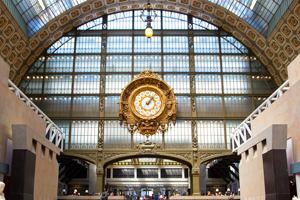From a railway station to the Musee d'Orsay
The most valuable collection of impressionist art in the world
 In 1977, President Valéry Giscard d'Estaing took the decision to save the fabulous railway station of Orsay (known in French as the Gare d'Orsay) from demolition and transformedit into the most sumptuouos impressionist museum in the world, the Musée d'Orsay.
In 1977, President Valéry Giscard d'Estaing took the decision to save the fabulous railway station of Orsay (known in French as the Gare d'Orsay) from demolition and transformedit into the most sumptuouos impressionist museum in the world, the Musée d'Orsay.
The building's restructuring took a long time but, when the work was finished, even the famous Édouard Detaille dared to describe it as "The station is magnificent and has the appearance of a Palace of fine arts." The Musée d'Orsay is one of the most famous museums in the world, as much for the artistic value of its collection, which includes works by the most famous exponents of impressionism, as for the beauty of the building itself. Together with The Louvre Museum it is considered to be one of the unmissable places to visit when in Paris.
The history of the building
One of the original architects involved in the design of the station d'Orsay, Victor Laloux, out of respect for the elegant ambience of the surrounding neighbourhood, (situated on the left bank of the Seine), opted for an elegant stone facade which would hide all the technical installations inside such as the lifts, hoists and other functional features of a station, from the hotel next door. The structure had already been much admired thanks to the Universal Exhibition and the architects who were involved in the resturcture paid similar respect to the ideology of the building, transforming it into a welcoming and suitably imposing structure in which to house the works of art that now found themselves under its roof.
The Museum
The museum is spread over three floors which surround the original central concourse. The interior, which was designed by a group of architects and set designers (headed up by the Italian architect, Gae Aulenti) created sensational setting for the valuable collection that the museum was destined to house, ensuring that the new design was in complete harmony with the original structure of the building. Great attention was paid to the use of natural light which would filter through from the large windows and because of this, many of the works inside the Musée d'Orsay seem to come alive which turns this into a truly unique experience for the visitor.
The collections
The museum's collections cover a period dating from the mid 1800's until just before The Great War (around 1914). A large number of the works, (sculptures, applied arts, paintings and more) originally came from other French museums such as: the Louvre, the historic Musée du Luxembourg, Jeu du Paume and the Palais de Tokyo. The beginning of the tour starts with an area that is dedicated to sculpture, (more than 2,000 works) amongst which are works by the famous Rodin. The tour continues with the decorative arts, (the Amont Pavilion) where you can admire furniture, jewellery, ceramics, glass and documents from this period in history. And then, to finish off, the paintings which, inevitably, occuply the largest space inside the museum and include works by some of the world's most famous artists, such as: Gauguin, Monet, Manet, Degas, Renoir, Cézanne and Van Gogh. In actual fact, the Musée d'Orsay's collection is quite broad and is able to provide a detailed snap-shot of the historical period that is covered by the museum tracing a journey from Delacroix through to late Romanticism, from the Barbizon School to Realism, from Impressionism to Symbolism. Amongst the unmissable works that we would highlight are
- "L'Absinthe" and "The Ballet Class" de Degas;
- "The Poppy Field," Blue Water Lilies," and "Regattas at Argenteuil" by Monet;
- "Rosebushes under the trees" by Gustav Klimt;
- "The bedroom at Arles" and "Self Portrait" by Van Gogh;
- "The Origin of the World," by Gustave Courbet.
Duration of the visit
A complete tour of the Musée d'Orsay should take about three or four hours but, if you are accompanied by a local guide, you can see the most important works and enjoy the best of the museum in just two hours! In order to request a private English-speaking guide, have a look at the page: English speaking Guide in Paris. A local guide who speaks your language can make your visit really special and inspiring whether you are visiting a museum or one of the typical Parisian neighbourhoods. Don't miss out on the chance to experience Paris to the full and return from your holiday with beautiful memories and fun adventures to tell your friends and family about.










